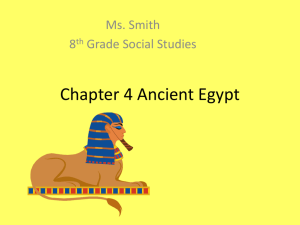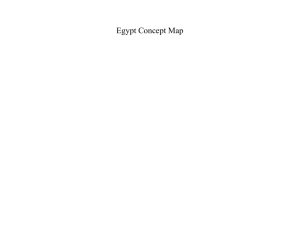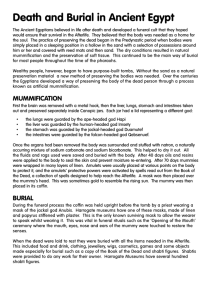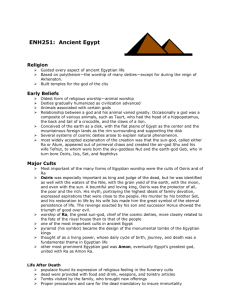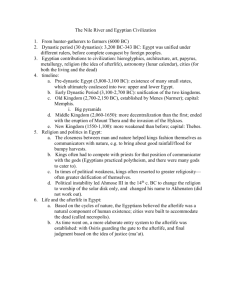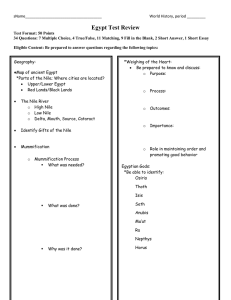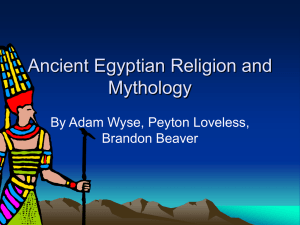Shabti Figure (powerpoint 3.39 mb)
advertisement
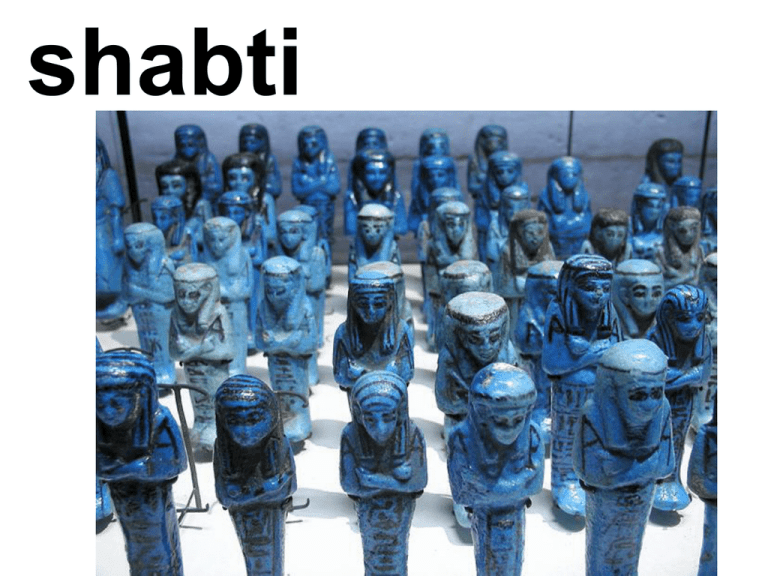
shabti Vocabulary/Glossary: shabti: a figurine called ‘answerer’ chore: an everyday task or job Anubis: an Egyptian god who protected the cemetery and guided the dead to judgement, usually shown as a jackal or a man with a jackal head Osiris: an Egyptian god who ruled the afterlife and judged the dead afterlife: the life ancient Egyptians expected after death plough: a pointed tool used to break up dirt shaduf: a machine to move water from one place to another sickle: a tool with a curved blade used to cut plant stalks threshing: separating the seeds of wheat or barley from their stalks chaff: coverings (husks) of seeds of wheat and barley that you can’t eat Shabti What does it look like? What does it feel like? How was it made? What was it made for? Is it well designed? Explanation: It is called a ‘shabti’, which is the ancient Egyptian word for ‘answerer’. The figurine ‘answered’ when the dead person called for it to do chores in the afterlife (once its owner had made a difficult journey, was guided to the judgement hall by Anubis, had his heart weighed and been judged by Osiris). Ancient Egyptians expected to do work for Osiris, the ruler of the afterlife. They could reduce their chores by having substitutes to work for them. Shabti figures were placed in tombs so that they could come to life through magic and work for Osiris on behalf of their owners. The most common work was farming in the fields of the afterlife. Shabti figures began to be placed in tombs from around 2000 BC and continued to be popular until the Romans conquered Egypt 2000 years later. Task: Imagine that you are a shabti. You have entered into the afterlife and you have been instructed by your owner to work in Osiris’ fields as a farmer (which is just like working in the fields of ancient Egypt). Create a series of movements with words to show Osiris all the different chores you are required to do in the course of a year. Look at the pictures about ancient Egyptian farming and the text to help you. Success Criteria: *Perform at least 3 chores in the right order *Use your whole body to show each chore *Use technical words (E.g. plough, sickle, shaduf) *Use time connectives (E.g. firstly, then, next, after that, finally) Ancient Egyptian Farming Every year, the Nile river floods the land for several months. Egyptian farmers had to wait for the water to go down. Then they would prepare the fields by building ridges to hold water in the fields and canals to bring water to the fields. Egyptians would use a shaduf to move water from the canal to the field. This machine is made using a large pole with a bucket at one end and a heavy weight at the other. The weight would make the full bucket easier to lift. Once the field was dry enough, farmers would break up the dirt with a plough and spread seeds on the field. It almost never rains in Egypt, so while the plants grew, farmers had to water the field using a shaduf. Egyptians planted many types of fruits and vegetables. Barley, wheat, flax, onions, and pomegranates were common crops. After a few months the plants would be ready to harvest. Wheat and barley were cut using sickles. The stalks were gathered and taken to a threshing floor where cattle would walk on them to separate the seeds from the stalks. Workers would then throw the seeds in the air so the wind would blow away the chaff. The seeds could then be gathered from the ground. Egyptians would use the wheat for bread and the barley to make beer. judgement before Osiris in the afterlife a farmer using a shaduf ploughing the fields harvesting grain using a sickle threshing grain separating seeds from chaff carrying crops – pomegranates and grapes Plenary Share the performances with the class (acting as Osiris!). *What chores can you recall? *How did they use the body to show each chore? *How did they use technical words? *Did they use time connectives?
